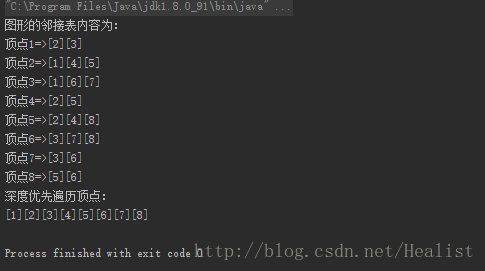深度优先遍历DFS 与 广度优先遍历BFS(java实现)
图的遍历方式有俩种:
- 深度优先遍历(DFS)
- 广度优先遍历(BFS)
(1)深度优先遍历(利用栈和递归来实现)
思路:先以一个点为起点,这里假如是点A,那么就将A相邻的点放入堆栈,然后在栈中再取出栈顶的顶点元素(假如是点B),再将B相邻的且没有访问过的点放入栈中,不断这样重复操作直至栈中元素清空。这个时候你每次从栈中取出的元素就是你依次访问的点,以此实现遍历。
class Node {
int x;
Node next;
public Node(int x) {
this.x = x;
this.next = null;
}
}
public class DFS {
public Node first;
public Node last;
public static int run[] = new int[9];
public static DFS head[] = new DFS[9];
public static void dfs(int current) {
run[current] = 1;
System.out.print("[" + current + "]");
while (head[current].first != null) {
if(run[head[current].first.x] == 0) { //如果顶点尚未遍历,就进行dfs递归
dfs(head[current].first.x);
}
head[current].first = head[current].first.next;
}
}
public boolean isEmpty() {
return first == null;
}
public void print() {
Node current = first;
while(current != null) {
System.out.print("[" + current.x + "]");
current = current.next;
}
System.out.println();
}
public void insert(int x) {
Node newNode = new Node(x);
if(this.isEmpty()) {
first = newNode;
last = newNode;
}
else {
last.next = newNode;
last = newNode;
}
}
public static void main(String[] args) {
int Data[][] = { {1,2}, {2,1}, {1,3}, {3,1}, {2,4}, {4,2},
{2,5}, {5,2}, {3,6}, {6,3}, {3,7}, {7,3}, {4,5}, {5,4},
{6,7}, {7,6}, {5,8}, {8,5}, {6,8}, {8,6} };
int DataNum;
int i,j;
System.out.println("图形的邻接表内容为:");
for(i=1;i<9;i++) {
run[i] = 0;
head[i] = new DFS();
System.out.print("顶点" + i + "=>");
for (j=0;j<20;j++) {
if(Data[j][0] == i) {
DataNum = Data[j][1];
head[i].insert(DataNum);
}
}
head[i].print();
}
System.out.println("深度优先遍历顶点:");
dfs(1);
System.out.println("");
}
}(2)广度优先遍历:(基于队列和递归的方式)
思路:基本操作是和深度优先差不多的,只不过这里是通过队列来实现的,找到一个起点A,并将A相邻的点放入队列中,这时将队首元素B取出,并将B相邻且没有访问过的点放入队列中,不断重复这个操作,直至队列清空,这个时候依次访问的顶点就是遍历的顺序。
class Node {
int x;
Node next;
public Node(int x) {
this.x = x;
this.next = null;
}
}
public class BFS {
public Node first;
public Node last;
public static int run[] = new int[9];
public static BFS head[] = new BFS[9];
public final static int MAXSIZE = 10;
static int[] queue = new int[MAXSIZE];
static int front = -1;
static int rear = -1;
public static void enqueue(int value) {
if(rear>=MAXSIZE) return;
rear++;
queue[rear] = value;
}
public static int dequeue() {
if(front == rear) return -1;
front++;
return queue[front];
}
public static void bfs(int current) {
Node tempnode;
enqueue(current);
run[current] = 1;
System.out.print("[" + current + "]");
while (front != rear) {
current = dequeue();
tempnode = head[current].first;
while (tempnode != null) {
if(run[tempnode.x] == 0) {
enqueue(tempnode.x);
run[tempnode.x] = 1;
System.out.print("[" + tempnode.x + "]");
}
tempnode = tempnode.next;
}
}
}
public boolean isEmpty() {
return first == null;
}
public void print() {
Node current = first;
while(current != null) {
System.out.print("[" + current.x + "]");
current = current.next;
}
System.out.println();
}
public void insert(int x) {
Node newNode = new Node(x);
if(this.isEmpty()) {
first = newNode;
last = newNode;
}
else {
last.next = newNode;
last = newNode;
}
}
public static void main(String[] args) {
int Data[][] = { {1,2}, {2,1}, {1,3}, {3,1}, {2,4}, {4,2},
{2,5}, {5,2}, {3,6}, {6,3}, {3,7}, {7,3}, {4,5}, {5,4},
{6,7}, {7,6}, {5,8}, {8,5}, {6,8}, {8,6} };
int DataNum;
int i,j;
System.out.println("图形的邻接表内容为:");
for(i=1;i<9;i++) {
run[i] = 0;
head[i] = new BFS();
System.out.print("顶点" + i + "=>");
for (j=0;j<20;j++) {
if(Data[j][0] == i) {
DataNum = Data[j][1];
head[i].insert(DataNum);
}
}
head[i].print();
}
System.out.println("深度优先遍历顶点:");
bfs(1);
System.out.println("");
}
}
